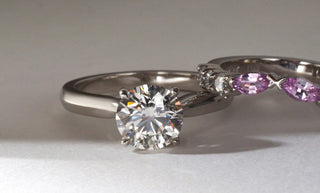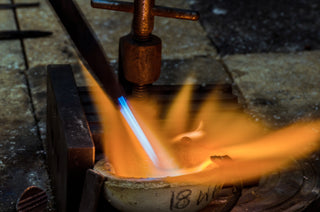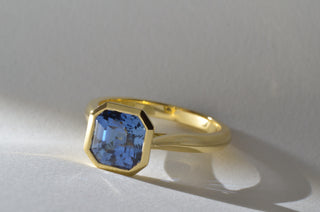When choosing between white gold and platinum, there are a few key factors to consider - colour, durability, maintenance, weight, and price. While both metals offer a beautiful and timeless appearance, they have distinct properties that may make one more suitable than the other, depending on the piece of jewellery and how you plan to wear it.
What is White Gold?
All gold starts as bright yellow when mined from the earth. White gold is created by alloying pure gold with other metals such as silver, copper, and palladium to achieve a whiter appearance. However, even after alloying, white gold still has a slight warmth or greyish hue rather than a true bright white.
The gold content in white gold is measured in carats (ct), which indicates purity:
- 9ct white gold – 37.5% gold, 62.5% alloy metals (often a warm white)
- 14ct white gold – 58.5% gold, 41.5% alloy metals (a balanced white)
- 18ct white gold – 75% gold, 25% alloy metals (a greyish-white tone)
Every jeweller has their own proprietary alloy mixture, which can affect the final colour. At Jewellers Workshop we can sometimes use a higher palladium content to achieve a cooler white, while others incorporate nickel for additional whiteness and improved casting properties. However, nickel can cause allergic reactions, so we choose not to use it - it's more commonly found in mass-produced jewellery.
What is Platinum?
Platinum is a naturally white metal that requires no alloying to achieve its colour. It is one of the densest and most durable metals used in jewellery, making it particularly well-suited for settings that require longevity, such as engagement rings. Unlike white gold, platinum does not require rhodium plating to maintain a bright white appearance.
Rhodium Plating: What You Need to Know
Since white gold is not a true bright white, it is common to apply a thin layer of rhodium plating to enhance its appearance. Rhodium is a rare metal in the platinum family, prized for its reflective, silvery-white finish. This plating is purely cosmetic and wears off over time, meaning it will need to be reapplied every 1–3 years for rings, depending on wear, and much less frequently for necklaces and earrings.
For men’s rings, we typically don’t recommend rhodium plating, as daily wear causes it to fade quickly. Many men also prefer the natural off-white or grey tone of our 18ct white gold or a high-palladium 9ct alloy.
Durability: White Gold vs Platinum
Both metals are highly durable but behave differently over time.
- Platinum is denser and more malleable, which makes it ideal for delicate settings, such as the fine prongs holding a diamond. Instead of wearing away, platinum tends to move under pressure, meaning it can be reshaped or polished back into place rather than thinning over time.
- White gold is more rigid and scratch-resistant, particularly in 14ct form. However, white gold does lose small amounts of metal over time as it wears down, making it more prone to thinning in high-wear areas like ring prongs.
An Analogy for Durability: Think of platinum like a piece of soft leather—it develops a patina and shifts under pressure but retains its strength. White gold, on the other hand, behaves more like a hard ceramic—it resists scratches well but can become brittle and wear away over time.
When to Choose White Gold
White gold is a great option for jewellery where weight is a consideration. The additional density of platinum can make larger pieces, such as necklaces and earrings, feel heavy, so white gold offers a more comfortable alternative. It can also be the more budget-friendly choice, particularly in 9ct or 14ct alloys, depending on market fluctuations.
When to Choose Platinum
Platinum is particularly well suited for engagement rings and diamond settings where durability is key. Its strength and malleability make it ideal for fine prongs, offering extra security for diamonds and gemstones. Many people also prefer platinum for its low-maintenance nature - it's colour never changes and it does not require rhodium plating, so there’s no need to worry about re-plating over time. Instead, it can simply be re-polished (which we offer at no charge) to restore its shine.
Price Differences
The price of gold and platinum fluctuates independently, so the cost difference can vary over time. Historically, platinum has always been the more expensive option, and some jewellers still charge a premium based on that perception. However, at the time of writing this, platinum is roughly the same price as 14ct white gold. *14ct white gold is slightly more expensive per gram, however platinum’s higher density means you need more of it to create the same piece, which can balance out the cost difference.
A Note on Density
You may have noticed that platinum is described as “denser” than white gold. This simply means that for the same physical size, platinum is heavier. This is why a platinum ring will feel more substantial on your finger than a white gold one of the same design.
Final Thoughts
Both white gold and platinum are excellent choices for fine jewellery, and the best option depends on your lifestyle, preferences, and how you plan to wear the piece. If you're unsure which to choose, we’d be happy to guide you through the options and help you find the perfect metal for your jewellery. Feel free to visit us in-store or get in touch to discuss your ideas!







